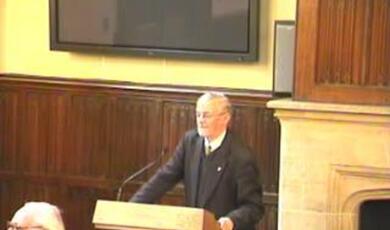'In All Things' or 'Beyond All Things'
Share
- Details
- Text
- Audio
- Downloads
- Extra Reading
This lecture explores the diversity of traditions about God or ultimate reality. Is the Deity one with, or present in, the universe - or beyond all, transcendent, 'Wholly Other'?
Download Text
'In all things' or 'beyond all things'?
Professor Gwen Griffith-Dickson
If there is a deity or ultimate reality of some spiritual kind, is it something that stands outside the world? Or is it something that is within the world? This question seems to be one of the most basic religious questions there is.
One of the most fundamental assertions for many who believe in a God at all is that this deity transcends everything else. This often means two things: first, that it is utterly different to everything else. God is not an angel, not a superman. Secondly, it suggests an absence of limit, infinity, boundlessness.
At the same time, many people claim, in contrast, that whatever is the ultimate reality, it underlies everything else. It is within everything else, perhaps its 'inner controller', as Brahman is called in the Upanishads. Or, if this deity is a separate being, it is nearer to me than my own jugular vein, as God is said to have told the Prophet Muhammad (pbuh).
Both of these convictions have been present from the beginnings of systematic religious reflection, as far as it has been recorded in writing, as can be seen both in Greek thought and in Indian thought. What is interesting to discover is that the divide between these opposed points of view does not divide religions. It is not the case, for example, that all Hindus believe that Ultimate Reality underlies everything that is, but is not a personal being; nor is it the case that all Christians think God is something that stands outside the universe as its creator. This divide runs through religions. Presocratic philosophers or Hindus, Muslims or Christians, both convictions are present in these broad rivers of religious thinking.
For that matter, it is not a difference between theologians and ordinary believers as you sometimes find; nor between philosophers and mystics. Mystics happily assert either of these claims; whether according to their mood, their latest experience, or some more stable religious conviction, I am not always sure. But we can find the Christian mystic Hildegard of Bingen portraying God as describing himself within all things, like this: 'I, the fiery life of divine essence, am aflame beyond the beauty of the meadows, I gleam in the waters, and I burn in the sun, moon, and stars.' The Muslim mystic Junaid goes further: 'There is none in my cloak but Allah.' At the same time, his fellow Sufi, Rumi, depicts God's absolute transcendence poetically as a flight from any imagery, description, or even ultimately from speech:
His name will flee, when it sees an attempt at speech,
so that you cannot even say, "So-and-so will flee."
He will flee from you, so that if you sketch his picture,
The picture will fly from the tablet,
the impression will flee from the soul.'
Are these two theological styles conflicting doctrines, logically contradictory, so that one cannot believe them both? Let us leave this question open for now, and view them as 'ways of speaking' about the divine, or as different 'discourses'. Let us investigate the accounts given in different religious traditions of both 'styles' of divinity.
Transcendence
Hindu philosophy, Judaism, Christianity, and Islam are all concerned to assert that God is unlimited. One way that philosophical reflection on God was begun in all four of these traditions is to make your starting point God's infinity. You begin by denying every possible limit to God. Thus the Brhadaranyaka Upanishad describes Ultimate Reality as '..the Imperishable, neither gross nor fine, short nor long, neither shadow nor darkness, air nor space, without taste or smell, nor ears nor voice, nor mind or radiance or breath, having no within and no without, eats nothing, nothing eats it.'
Another aspect to this emphasis on the deity as beyond all that we are or comprehend is to stress the difference between God and everything else. 'There is nothing like Him', both the Bible and the Qur'an tell us. The language, imagery and philosophical claims all try to mark off the divine from what is experienced in concrete ways in the world. It is 'higher': 'Higher than this is Brahman, the supreme, the great hidden in all creatures according to their bodies, the one who envelops the universe, knowing Him, the Lord, [we] become immortal.' 'Than whom there is naught else higher, than whom there is naught smaller, naught greater, (the) one stands like a tree established in heaven, by Him, the Person, is this whole universe filled.' This ultimacy can also be expressed as containment of the world within the divine or ultimate: 'All this, whatever moves in this moving world, is enveloped by God.' 'He in whom the sky, the earth and the interspace are woven as also the mind along with all the vital breaths, know him alone as the one self.'
Frequently this assertion is accompanied by a claim that this transcendence means a transcendence of human cognition, knowledge, understanding, language. The ultimate divine reality is 'unmoving, one, swifter than the mind. The senses do not reach it as it is ever ahead of them. Though Itself standing still it outstrips those who run. In It the all-pervading air supports the activities of beings.' 'Other is it than the known, and above the unknown.'
If we turn to the other way of speaking, the texts that seek the divine within the world, we find that there are three distinct manners in which religious traditions seek to understand a connection between God and the world. One is the view, which people often take to be 'primitive', which sees God or gods within the world. 'Stationed within the world' is the way that Werner Jaeger puts it, when talking about the Greek gods. Another is to assert that there is an underlying identity between the material world and God. They are, despite appearances, ultimately one in being, identical. The third way is to assert that God is somehow 'immanent', present within, creation.
Gods in the world
Religions who place their gods within creation are usually given short shrift within the realms of philosophy. They may be seen as primitive; superseded or supplanted by later religious developments, as in Greece. Where they still remain, they may be known tactfully as 'indigenous religions' more or less conceding that no-one else could possibly believe in them. It may be, however, that the metaphysical framework that non-Western peoples are working with are not founded upon this idea that ultimate reality must be deeper or other than the world we see; that what is visible is mere 'appearance'. Their view of the sacred may be no more primitive and mythological than ours.
[Show video of Hawaiian sacred dance and discuss.]
The discourse of identity
Views that think there is only one kind of substance in the universe are often called 'monist' views. Some 'monist' views, often called materialism, think that there is only matter, and no spirit or divine. But there is a religious monism that believes that spirit alone is real, and the material world is an illusion; or that what we see as a difference between spirit and matter is an illusion, and both are the same thing.
We can see different styles of asserting this kind of identity between spirit and world. One is to say that all the material world is God, a view often called 'pantheism'. The other is sometimes referred to as 'acosmism' ('not-world'): spirit or the Absolute is what is ultimately real, and material things are a mere appearance with
lesser or no reality.
Pantheis
Although pantheism is much talked about, and some suggest might be about to undergo a revival in New Age religious thinking, it is surprisingly difficult to find thinkers who assert that matter is fully real and itself divine. More often texts which are cited as examples of pantheism actually slide off subtly in a different direction; the divine is fully within the material world, but matter itself is not divine; there is some 'first principle' or 'inner principle' underlying all things but not identical with them. Those who truly believe there is nothing above and beyond nature often find nature itself wondrous enough and worth reverence without giving it a divine spin (leaving the '-theism' out of 'pantheism', as it were). Two thinkers who could however be called 'real pantheists' are Spinoza and Haeckel. Spinoza is a 'pantheist' for logical reasons; he believes that there can only be one substance, so God and the universe must be identical in substance. 'God is one, that is, only one substance can be granted in the universe.' 'Besides God, no substance can be granted or conceived.' 'Whatever is, is God and without God nothing can be, or be conceived.' So God cannot be differentiated from the world as a whole. Individual things, then, are modes or modifications of the attributes of God; concretely, for example, our love for God and God's for us is identical.
Most people nowadays do not operate with a concept of 'substance', so most would-be pantheists can't really follow Spinoza's lead. One who still retained that language was Ernst Haeckel, who believed: 'Matter, or infinitely extended substance, and spirit (or energy), or sensitive and thinking substance, are the two fundamental attributes or principal properties of the all-embracing divine essence of the world, the universal substance.' 'The idea of God is identical with that of nature or substance . . . In pantheism God, as an intramundane being, is everywhere identical with nature itself, and is operative within the world as force or energy . . .'
Acosmism
'Truly, this whole world is Brahman, from which he comes forth, without which he will be dissolved and in which he breathes.' The monist way of interpreting and expounding the Upanishads maintains that all conceptual distinctions that we apply to reality are ultimately false. It is ignorance and false perceptions that lead to this mistake. The ultimate principle, Brahman, underlies all reality as its true Self, and individual human selves are not fundamentally to be distinguished from Brahman.
Brahman, which is what is most real, contains no differentiation and transcends all distinctions, even the distinction of subject and object. The world we see does exist, but as an 'appearance'. What is true above all is that the Self (atman), one's own truest self, is not different from Brahman, nor is anything else. 'Now the light which shines above this heaven, above all, above everything, in the highest worlds beyond which there are no higher, verily, that is the same as this light which is here within the person.' As the Chandogya Upanishad puts it: 'this is the self of mine within the heart; this is Brahman.' It is this knowledge that leads to liberation and enlightenment.
Boundless permeation
In Indian religion, there is in fact a spectrum from those who assert absolute identity and monism, and those who insist on a dualist view of selves and matter, or of Brahman and human selves. The Upanishads can also be interpreted in a non-monist way. There passages which speak of Brahman as 'inner controller', the 'thread that holds the world together':
who dwells in earth, water, fire, sky, air, heaven, sun, quarters, moon and stars, ether, darkness, light, all beings, breath, speech, eye, ear, mind, skin, the understanding, semen; yet is within each of them, whom each of them does not know, whose body each of them is, who controls each of them from within, he is your self, the inner controller, the immortal.
Such Upanishadic texts suggest the immanence of Brahman or the Supreme Self in one's own self and in the world, without necessarily asserting an absolute identity between Brahman and creation. The Svetasvatara Upanishad contains a number of images that evoke the idea of presence within, without annihilating the character of the host. 'As oil in sesame seeds, as butter in cream, as water in riverbeds, as fire in friction sticks, so is the Self seized in one's own soul if one looks for Him with truthfulness and austerity.' 'As fragrance is in the flower, as butter in milk, as oil in sesame seeds, as gold in the reef of gold (so God dwells in all objects)'. 'He, indeed, is the God who pervades all regions, He is the first-born and he is within the womb. He has been born and he will be born. He stands opposite all persons, having his face in all directions.' Thinkers such as Ramanuja have denied that there is only one reality, Brahman; and have maintained that our own selves are different, though they have Brahman as their source. Ramanuja's view of the relationship between Brahman and the rest of us is 'identity in and through and because of difference'. Individual selves like you and me derive from God, are modes and expressions of God, but are not absolutely identical. 'The divine Supreme Person… having himself entered into those selves as their inner self, abides within them, controlling them as an animating and cheering principle.'
You might call that view something like 'boundless permeation'. The divine absolutely saturates all that is. That is one way of conceiving the 'immanence' of the divine.
In-and-through immanence
Many believers, in particular monotheists like Muslims, Jews and Christians, feel that God is something separate from us, yet somehow unbelievably close. Thus the way they speak about God's presence in the world takes different terms within the language of 'immanence'. They struggle to speak of God as no less close than Ramanuja's Brahman; but are more concerned to give God a separate identity or person-hood. Their infinite God has nevertheless a boundary of personality.
This discourse of immanence describes God as thoroughly present in the universe in its entirety, rather than standing apart from it. But as the universe does not exhaust God-there is more to God than the material universeGod is not only the spirit within things. Such a view is often called panentheism ('God in all'). In this view, God isn't just the same thing as the world. On the other hand, all things only exist within God and have no independent existence from God. There is a God outside the world, but no world outside God.
The Jewish philosopher Martin Buber equated the mystics' language of identification with God (as he views it) as the language of lovers who get carried away and feel and say that they are completely one, but are not literally so. Instead of speaking of identification with God (as he portrays mystics as doing), he prefers speaking of relationship with God. For Buber, we are not one with God, and we are not called upon to leave the world to achieve oneness with God either. 'God embraces but is not the universe; just so, God embraces but is not my self.'
Christian theological language of immanence speaks of God present within creation, of working in and through creatures to achieve the good. At the same time, this assertion of God's presence is often countered with an assertion that God is unbounded, perhaps to prevent any possible implication of pantheism. This often results in paradoxical utterances as God is 'every present and nowhere included'; or Augustine's famous metaphor: 'God is a circle whose centre is everywhere and whose circumference is nowhere.' As Meister Eckhart wrote: 'The One descends into everything and into each single thing, yet remaining the One that unites what is distinct.' God is fully immanent within the whole of creation, without abolishing the distinct identity and uniqueness of each entity.
Christian religious language frequently uses language of God animating what exists, in order to assert God's relation, both intimate and almighty, to the world. Mystics and spiritual writers can often carry off this manoeuvre particularly well. Hildegard of Bingen, as we have already seen, portrays God as saying:
I, the highest and fiery power, have kindled every spark of life . . . I, the fiery life of divine essence, am aflame beyond the beauty of the meadows, I gleam in the waters, and I burn in the sun, moon, and stars. With every breeze, as with invisible life that contains everything, I awaken everything to life. The air lives by turning green and being in bloom. The waters flow as if they were alive. The sun lives in its light, and the moon is enkindled, after its disappearance, once again by the light of the sun so that the moon is again revived . . . And thus I remain hidden in every kind of reality as a fiery power. Everything burns because of me in the way our breath constantly moves us, like the wind-tossed flame in a fire.
Concluding remarks
There are many ways, or many criteria against which we could evaluate these differing points of view. One is to interrogate these ways of speaking about God for the impact they have on our own ethical behaviour. For example, does the account we give of God's relation to the world affect the way we see the world? Are we more, or less, likely to respect the earth and treat it gently if we view God as identified with it? As theologian Anne Primavesi writes, 'For our descriptions of how God is perceived to relate to the world (and vice versa) can be seen, ultimately, as a matter of vital personal concern, one which shapes, and at the same time validates, certain interactions with our environments, and by doing so, validates our perception of ourselves. And in shaping our actions to correspond with that perception, they can also be of vital concern to those with whom we interact.'
It would be easy to suppose that a pantheist God is more environmentally friendly. But I wonder. I suspect that only a truly transcendent God can be truly immanent; and only a God who is not creation can relate in love to creation. Primavesi also speaks of a God who is 'manifested in freedom and spontaneity for and to us and to all living beings in myriad ways over eons of time'. I leave it to you to reflect whether that freedom in fact suggests transcendence.
So are these two ways of speaking about God in conflicttranscendence and immanence? Must the believer choose whether God is beyond all things or within all things, but not have it both ways? I suggest not. How truly can you really have your cake unless you eat it?
Monotheists have hit upon several strategies to have and eat their cake at least, that is one way to describe certain of their doctrines. One is fairly new or at least unusual in Western reflection, though familiar in the East. Ramanuja used the analogy of the mind-body relationship to portray the relationship of the Lord to the world. Just as one's own spirit is present to all of one's body, and identified with it, but more than it, so too is the Lord to the universe.
Two Western thinkers have happened on a similar analogy and interpreted God's omnipresence to the world analogously with the mind and the body. Thus Charles Hartshorne suggests that God has immediate, direct knowledge of the entire universe as we have immediate and direct knowledge of our own body; indeed, Hartshorne suggests that the world is God's body. Swinburne suggests a 'limited embodiment' of God, also beginning from the idea of a mind-body analogy.
Grace Jantzen has taken the idea of the world as God's body furthest yet. Her work is a critique of the idea of God's bodilessness, which she rejects as based on an undesirable mind-body dualism. Her argument is that the relationship between God and the world is 'analogous' to the relationship between human person and his or her body when viewed in a holistic, not a dualist, fashion. Just as human persons have a kind of 'transcendence', that is, they cannot simply be reduced to their physical aspects, in this way the world can be viewed as the embodiment of a transcendent God. God's embodiment in the universe means the world is God's self-expression, self-formation, while 'it remains the case that there is a difference between God and the world'. It is unclear how far she wants this to be understood as a metaphor or analogy, and how far she wants us to take it as (in some way) literal. Either way, we have begun to see interesting challenges in Western philosophy of religion to the age-old view that God is incorporeal, without a body.
A more conventional strategy used by monotheists to portray God as present in the world is the idea of omnipresence. The Qur'an teaches: 'Whichever way you turn, there is Allah's face'. An Indian Islamic story tells of Moses calling out, asking God where he is. God answers: 'I am front of you and behind you, to your right and to your left, and everywhere. When any creature remembers me, I am by his side, and when he calls Me, I am near him.' Religious philosophers then have often used the attribute of omnipresence as a way of representing God's boundlessness, while remaining present everywhere; just as theologians have used it as a way of asserting God's simultaneous transcendence and immanence: 'Name any place, and he is already there.' Anselm, in struggling to understand omnipresence, observes that it must mean that God is present, but not contained in place and time. It would be more appropriate to say God is with all places and times than in them. While we want to say that God is in all places, we really mean God is in no place if that means contained by it.
Aquinas, a great defender of God's transcendence, also speaks of God's omnipresence as a kind of immanence. For him, this follows from the belief that God is Being Itself. 'Hence it must be that God is in all things, and most intimately. . . . He acts immediately in all things. Hence nothing is distant from Him, as though it did not have God in itself.' God fills every place not as a body does, but by giving being to the things do that fill that place. In fact all God's attributes make him omnipresent, according to Aquinas. 'God is in all things by His power, inasmuch as all things are subject to his power; He is in all things by His presence in all things, inasmuch as all things are bare and open to His eyes; He is in all things by His essence, inasmuch as He is present to all as the cause of their being'. Thus, by virtue of other attributes that relate God to the world, God is seen to be omnipresent, as knowing all, controlling all, causing all. God is everywhere by virtue of his power, by his presence, by his essence as the cause of all our being.
Whether we are talking about incorporeality or omnipresence, I suggest a slightly different starting point: the capacity to be available to all. The spatial, physical or 'place' aspect is not the point in talking about God. Neither is power nor knowledge, neither cause nor control, the point of God's immanence; but the kind of relationship with each creature that it makes possible. 'Omnipresent' means continual availability to everyone, without restriction by anything. The very attributes that suggest God's transcendence of the world at the same time ensure all the more intimate a contact with creation. Seeing omnipresence as an absence of limit in the presence and availability of the divine interprets immanence as the mode of relationship that allows for the closest possible intimacy.
The conflict over God's incorporeality can also be resolved in this way. God's limitlessness is not the antithesis to what is bodily or physical. It means that nothing can limit God's presence to, presence in, or indeed presence with all matter, all places, all bodily beings. To suggest that God does not 'have a body' means that not even matter itself restricts God's perfect presence in the world.
What is necessary is to challenge the idea that transcendence and involvement with the world are mutually exclusive. Many assume that the more involved the deity is with the world, the less transcendent it is, and vice versa. The reverse I believe is the case. The more you insist that transcendence means the negation of involvement in the world, the more you limit God's being and action. God becomes finite because there is a limit set for God precisely where the world starts. On a different view, what makes God radically different from every creature is God's ability to be intimately connected with every creature, transcending all opposition.
Language straining
Although the 'orthodox' view in Judaism, Christianity and Islam is that there remains a distinction between God and the world, one also finds texts such as these from Eckhart, particularly among the writings of mystics:
Between that person and God there is no distinction, and they are one. . . Their knowing is one with God's knowing, their activity with God's activity and their understanding with God's understanding.
The strongest statements of immanence within monotheistic writers in fact look indistinguishable from the language of monists, who assert an absolute unity of human selves with the divine Self. When trying to convey an extreme of intimacy, intimacy strains towards identity and perhaps crosses the line. This does not only happen with respect to the individual relationship between the creature and God, but also when discussing the relationship between God and the world, as we see in this Jewish writer:
The essence of divinity is found in every single thing - nothing but it exists. Since it causes every thing to be, no thing can live by anything else. It enlivens them; its existence exists in each existent. Do not attribute duality to God. Let God be solely God. …Do not say 'This is a stone and not God.' God forbid! Rather, all existence is God, and the stone is a thing pervaded by divinity.
As we have seen, Buber wants to explain such utterances as Eckhart's about the unity of God and the believer as exaggeration, the enthusiasm of the lover. This interpretation could be applied to those apparently asserting an identity between God and the world. Perhaps monist writing from other religious traditions should be interpreted with equal delicacy and caution?
'Identity' vs. 'immanence', 'pantheism' vs. 'panentheism' perhaps these are all-important religious distinctions, but they are also very fine ones. If you want to decide from their writings where thinkers stand on these questions, you may be asking for a precision and certainty about language that in most cases does not exist. Do they mean it literally or figuratively? when you are talking about God, where does the difference between literal and poetic really lie? Not where we usually think it lies in our speech in the physical realm.
When confronting issues on the edges both of philosophy and of mysticism, it is not so easy to say what the difference between 'literal' and 'figurative' speech actually is. If you ask a mystic or a philosopher whether their language on this question is perfectly adequate to express exactly what they are trying to convey, they are likely to say 'No!' And that is not much help. 'Is what you say literally how God really is? Or is it just your way of expressing yourself? Are you saying you are really one with God or does it just feel like that?' Such philosophers as we have been discussing-and their mystical colleagues- would view such questions as evidence of our lack of understanding. Whether God is literally or 'physically' in all things, or it just feels like that, is just not a question that makes any sense if you have really absorbed what they are trying to tell you.
These are not issues to do with substance, as if the crucial religious question concerns the stuff-ness of God and the universe. Rather, they are attempts to convey the experience of a relationship, or insights into its nature. As such, it would be odd if they did not differ. But even the monist and immanentist monotheist seem to agree in their desire to assert a perfect intimacy between God and the world; not even difference itself can bound or limit the perfect relatedness and perfect availability of the Absolute with creation.
I suggest then that we see these contrasting, often conflicting discourses as ways of describing a relationship that has many aspects. The language of God's transcendence, ultimate reality as beyond anything we can know, describe, or capture is an essential way of asserting the ultimacy of the divine but also its freedom. In the end, we must assert that God escapes our formulae and is free of our dogmas.
At the same time, the discourses of identity and immanence are essential for those who want to assert God's intimacy and availability to us. To be God is to be perfection in relation; while never controlled or manipulated, always there; while unknowable, yet perfectly intimate. This dynamic relation of transcendence and immanence also points the way to solve the philosopher's (and the mystic's) age-old problem about knowing God. It is God's transcendence (or difference) above all that problematises human knowledge of the divine. But perhaps God's immanence (or identity) can also suggest a theological solution. Hildegard tells us that it is God whom we know in every creature. This was one of Hamann's most oft-repeated insights: that the whole of creation, nature and humanity with it, are revelations of God, the 'sensuous revelation of God's majesty' , the key to understanding our own nature, the revelation not of itself, but of something higher. If one holds that God is identified with or immanent in the world, then the world itself becomes what Indian philosophers call a 'pramana', a possible mode of knowledge, a way of knowing God.
If so, then God even as Wholly Other is also the Other of his own Otherness.
© Gwen Griffith-Dickson, 8 October 2002
This event was on Tue, 08 Oct 2002
Support Gresham
Gresham College has offered an outstanding education to the public free of charge for over 400 years. Today, Gresham College plays an important role in fostering a love of learning and a greater understanding of ourselves and the world around us. Your donation will help to widen our reach and to broaden our audience, allowing more people to benefit from a high-quality education from some of the brightest minds.


 Login
Login







